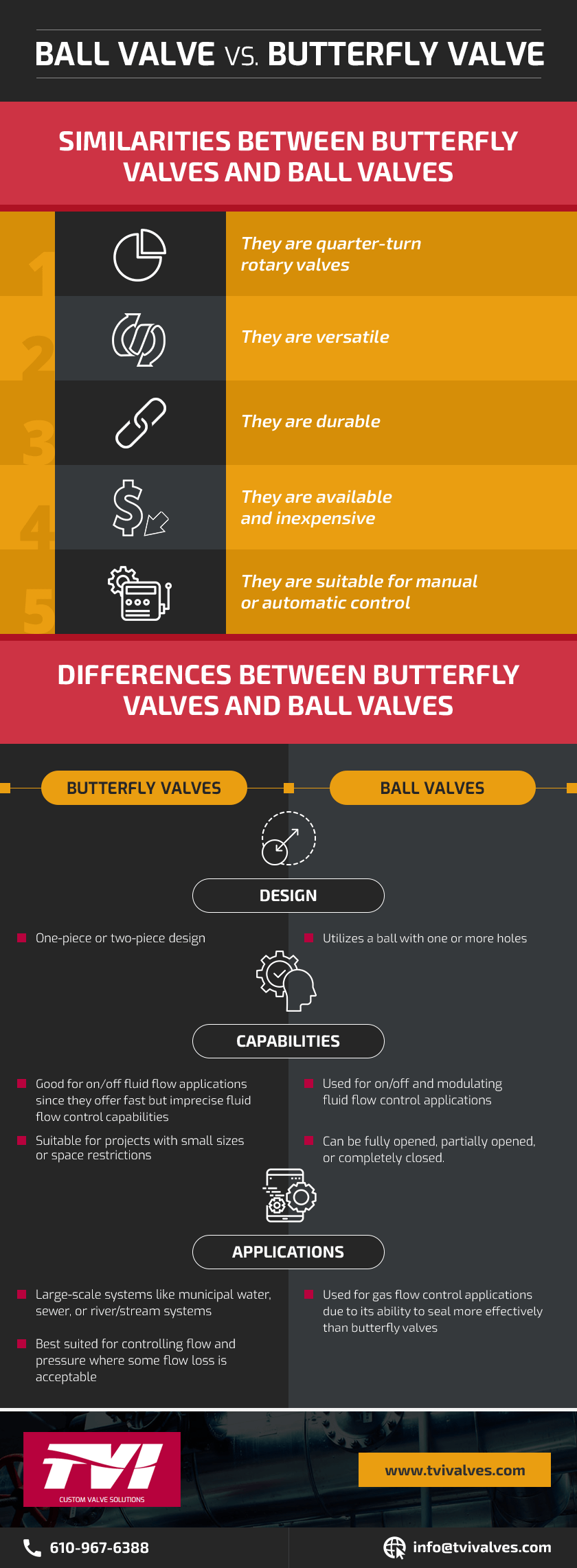Butterfly Valve vs. Ball Valve
Both butterfly valves and ball valves are commonly used to control the flow of fluid within a system. While the two have a number of similarities that make them suitable for some of the same applications, they also have key differences that make one better suited over the other for certain applications.
Below, we highlight the similarities and differences between butterfly valves and ball valves to help readers identify which one is right for their system.
Similarities Between Butterfly Valves and Ball Valves
The main similarities between butterfly valves and ball valves are:
- They are quarter-turn rotary valves. Both valves have a quarter-turn rotary design, meaning they turn 90° between their fully open and fully closed positions.
- They are versatile. Both are suitable for use in fluid flow control applications involving a broad range of temperatures and pressures.
- They are durable. Both of these valves are often made from highly durable metals (e.g., brass, cast iron, and stainless steel) that enable them to offer reliable performance over extended periods with minimal maintenance.
- They are available and inexpensive. Both valves are widely available from numerous suppliers at a relatively low price point.
- They are suitable for manual or automatic control. Both valve types can be controlled manually or by an electric or pneumatic actuator.
While butterfly valves and ball valves have many similarities, they are not interchangeable for all applications. It is important to consider the differences between them as they can affect when one should be used over the other.
Differentiators of Butterfly Valves
Some of the unique characteristics of butterfly valves include:
Design
Butterfly valves have a one-piece or two-piece design that resembles the wings of a butterfly. The one-piece design features a flat disc mounted on a shaft that rotates within the valve opening, while the two-piece design features sections that fold inward in the open position and lie flat in the closed position. In both variations, turning the closure mechanism 90° positions it either parallel (open) or perpendicular (closed) to the flow of fluid.
Capabilities
Butterfly valves are typically used for on/off fluid flow applications since they offer fast but imprecise fluid flow control capabilities. Additionally, due to their low cost and light weight, they can be constructed in small sizes to suit projects with space restrictions or large diameters to suit projects with large-scale systems. However, since part of the closure mechanism is always in the path of fluid flow, they always cause some pressure drop.
Applications
Butterfly valves are commonly used in large-scale systems (e.g., municipal water, sewer, or river/stream systems) since they are inexpensive and easy to maintain. They are best suited for controlling flow and pressure in applications where some flow loss is acceptable.
Check out this article to learn more about butterfly valves.
Differentiators of Ball Valves
Some of the unique characteristics of ball valves include:
Design
Ball valves utilize a ball with one or more holes running through it as the valve closure mechanism. The ball can be positioned such that hole(s) completely block(s), partially block(s), or completely allow(s) the flow of fluid through the valve.
Capabilities
Ball valves can be used for on/off and modulating fluid flow control applications since they can be fully opened, partially opened, or completely closed. Additionally, they are suitable for gas applications (since they create tight seals in the closed position) and high-pressure applications (since they turn easily even when there is a pressure difference on both sides).
Applications
Ball valves are commonly used for gas flow control applications since they can seal more effectively than butterfly valves. They are a popular choice for petroleum refining, gas processing, power plants, and more.
Check out this article to learn more about ball valves.
Are Ball Valves or Butterfly Valves Right for My Needs?
Knowing the similarities and differences between butterfly valves and balls valves can help you determine which one is right for your application. If you want additional assistance choosing the best valve solution for your needs, ask the experts at TVI Valves.

